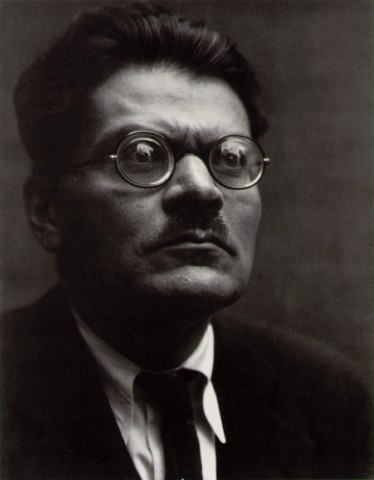- José Clemente Orozco
Infobox Artist
name = José Clemente Orozco
Born =

imagesize = 200px
caption = José Clemente Orozco. "Photo Credit:"Edward Weston
birthname =
birthdate = birth date|1883|11|23|mf=y
location =Ciudad Guzmán , Mexico
deathdate = death date and age|1949|9|7|1883|11|23|mf=y
deathplace =Mexico City , Mexico
nationality = Mexican
field =Painting ,Muralist
training = San Carlos Academy
movement =Social Realism
works =
patrons =
awards =José Clemente Orozco (
November 23 ,1883 –September 7 ,1949 ) was a Mexican social realist painter, who specialized in boldmural s that established "Mexican Mural Renaissance" together with murals byDiego Rivera ,Siqueiros , and others. Orozco was the most complex of the Mexican muralists, fond of the theme of human suffering, but less realistic and more fascinated by machines than Rivera. Mostly influenced by "Symbolism", he was also agenre painter and lithographer. Between 1922 and 1948, Orozco painted murals inMexico City ,Orizaba ,Claremont, California ,New York City ,Hanover, New Hampshire ,Guadalajara, Jalisco , andJiquilpan, Michoacán . Hisdrawing s and paintings are exhibited by the Carrillo Gil Museum in Mexico City, and the Orozco Workshop-Museum in Guadalajara.cite web |title=Tragedy and Triumph: the Drama of José Clemente Orozco 1883 - 1949|url=http://www.mexconnect.com/mex_/history/jtuck/jtorozco.html |publisher=Mexico Connect |accessdate=2007-09-21]Life and work
José Clemente Orozco was born in Zapotlán el Grande (now
Ciudad Guzmán ),Jalisco to Rosa de Flores Orozco. He married Margarita Valladares, and had three children.José Guadalupe Posada , a satirical illustrator whose engravings about Mexicanculture and politics challenged Mexicans to think differently about post-revolutionary Mexico, worked in full view of the public in shop windows located on the way Orozco went to school. In his autobiography, Orozco confesses, "I would stop [on my way to and from school] and spend a few enchanted minutes in watching [Posada] … This was the push that first set my imagination in motion and impelled me to cover paper with my earliest little figures; this was my awakening to the existence of the art of painting." (Orozco, 1962) He goes to say that watching Posado's engraving decorated gave him his introduction to the use of color. After attending school for Agriculture and Architecture, Orozco studied art at theSan Carlos Academy.With
Diego Rivera , he was a leader of the "Mexican Mural Renaissance." An important distinction he had from Rivera was his critical view of theMexican Revolution . While Diego was a bold, optimistic figure, touting the glory of the revolution, Orozco was less comfortable with the bloody toll the social movement was taking. Orozco is known as one of the "Big Three" muralists along with Diego Rivera andDavid Alfaro Siqueiros . All three artists, as well as the painterRufino Tamayo , experimented withfresco on large walls, and elevated the art of the mural.Between 1922-1924, Orozco painted the murals: "The Elements", "Man in Battle Against Nature", "Christ Destroys His Cross", "Destruction of the Old Order", "The Aristocrats", and "The Trench and the Trinity" at the
National Preparatory School . In 1925, he painted the mural "Omniscience" at Mexico City's House of Tiles. In 1926, he painted a mural at the Industrial School in Orizaba,Veracruz .Between 1927-1934 Orozco lived in the USA. In 1930, he painted murals at the
New School for Social Research ,New York City , now known as theNew School University . One of his most famous murals is "The Epic of American Civilization" atDartmouth College ,New Hampshire , USA. It was painted between 1932 and 1934 and covers almost 300 m² (3200 square feet) in 24 panels. Its parts include: "Migrations", "Human Sacrifices", "The Appearance ofQuetzalcoatl ", "Corn Culture", "Anglo-America", "Hispano-America", "Science" and "Modern Migration of the Spirit" (another version of "Christ Destroys His Cross").After returning to Mexico in 1935, Orozco painted in Guadalajara, Jalisco - among others - the mural "The People and Its Leaders" in the Government Palace, and the frescos for the Hospicio Cabañas, which are considered his masterpiece. In 1940 - for the Gabino Ortiz Library in Jiquilpan, Michoacán. Between 1942-44 - for the Hospital de Jesús in Mexico City. Orozco's 1948 "Juárez Reborn" huge portrait-mural was one of his last works.
Orozco died in 1949 in Mexico City.
The Dartmouth Mural
Jose painted this mural in the College hallway.
Exhibitions
"¡Orozco!" by The Ministry of Foreign Affairs and the Institute of Fine Arts, Mexico at The Museum of Modern Art, Oxford, 1980
Bibliography
*Anreus, Alejandro. "Orozco in Gringoland: the Years in New York". University of New Mexico Press. Albuquerque. 2001.
*Elliott, David, ed. Hurlburt, Laurance P. "The Mexican Muralists in the United States". University of New Mexico Press. Albuquerque. 13-88. 1989.
*Orozco, Jose Clemente. "An Artist in New York: Letters to Jean Charlot and Unpublished Writings". Austin. 1974.
*Orozco, Jose Clemente. "An Autobiography". University of Texas Press. Austin. 1962.
*Reed, Alma. "Orozco". Oxford University Press. New York. 1956.References
External links
* [http://www.mexconnect.com/mex_/history/jtuck/jtorozco.html MexConnect.com]
* [http://hoodmuseum.dartmouth.edu/collections/orozco-murals.html "The Epic of American Civilization" at Dartmouth.edu]
* [http://artscenecal.com/ArtistsFiles/OrozcoJC/OrozcoJCPics/OrozcoJC1.html "Prometheus", fresco mural; 20' x 28' 6", at ArtsCenecal.com]
* [http://www.abstract-art.com/abstraction/l2_Grnfthrs_fldr/g006b_orozco_zapata.html "Zapata", Oil on canvas; 178.4 x 122.6 cm, at Abstract-Art.com]
* [http://www.humanities-interactive.org/splendors/ex048_21c.html "Christ Destroying his Cross", Oil on canvas; 36 5/8 x 511/8 in., at Humanities-interactive.org]
* [http://www.explore-guadalajara.com/HospicioCabanas.html Man of Fire and other murals at Hospicio Cabañas]
Wikimedia Foundation. 2010.
